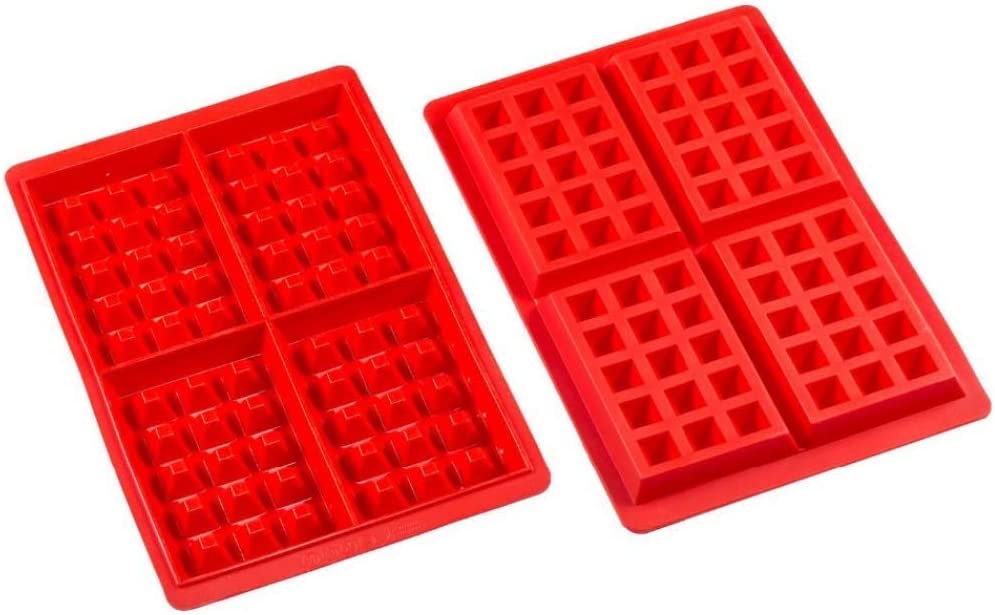Ditch the Teflon: The Ultimate Guide to Safe Cookware
Want to get rid of your Teflon but don’t know how to shop for safe cookware? In this Ultimate Guide to Safe Cookware, I walk you through the options for outfitting your kitchen with safe cookware and bakeware that will help your family stay healthy.

Want to get rid of your Teflon but don’t know how to shop for safe cookware? In this Ultimate Guide to Safe Cookware, I walk you through the options for outfitting your kitchen with safe cookware and bakeware that will help your family stay healthy.

Note: These safe cookware options are not listed in order of preference or safety — I recommend any and all of these options.
Also, I am using affiliate links in this post. You can order any of these items on Amazon. If you order via my links I will earn a small commission. Thank you for supporting my blog.
Why You Need to Ditch the Teflon Now
It doesn't matter how healthy the food you are eating is, if you're cooking with pots and pans that leach toxic heavy metals into your food.
Okay, so what’s so bad about Teflon and all of that "non-stick" cookware? I can explain why you need to dump all your Teflon with just one word: fluoride.
Fluoride causes acne, cysts, cancer, diabetes, cavities, bone loss, menstrual cramping and other hormonal problems. My former assistant was able to completely eliminate her migraines (which she used to get on a weekly basis) by getting all of the fluoride out of her diet.
It’s not easy to avoid fluoride, since it’s in almost everything. Food that is not organic is sprayed with fluoride-based pesticides. Grapes, raisins and wine from California are especially high in fluoride, and kombucha and tea are loaded with fluoride.
One of the worst sources of fluoride is the Teflon we cook with. According to a study from 1975 published in the Journal of Dental Research, Teflon or non-stick cookware and bakeware increase the fluoride in your food by up to 3 times. (Source)
It’s hard to avoid exposure to Teflon when eating out, or eating processed, packaged foods, since Teflon is used in most restaurants and food processing. However, most of us eat at home the majority of the time, and when eating at home, you should avoid using Teflon for cooking.
Read more about the dangers of fluoride here.
Read more about the top sources of fluoride here.
Types of Cookware I Do Not Recommend
The following types of cookware and bakeware are not recommended.
1. Teflon (non-stick cookware) – Teflon increases fluoride in the food by 3 times. This is one of the biggest sources of fluoride in our diet. It’s very hard to get rid of the fluoride after it’s stored in our bones and tissues (kidney, brain, breasts, ovaries, prostate) — because fluoride has a 20-year half life. Everyone should throw out their Teflon immediately.
2. Aluminum – Like fluoride, aluminum leaches into food during cooking. I’d like to skip the Alzheimer’s disease, thank you very much!
3. Copper – Many nutritionists say that many of us are too high in copper (copper toxicity). Best to avoid.
4. Anodized Aluminum (Calphalon) – Many people say anodized aluminum is safe because the aluminum is coated and won’t leach. However, I’ve heard horror stories like this one — someone who only had a saucepan for 8 years. Cast iron and enameled cast iron will last you a lifetime, so I don’t see the point in buying Calphalon.
Types of Safe Cookware I Do Recommend
I recommend 7 kinds of safe cookware and bakeware. These are the pots, pans and baking dishes I use in my own kitchen and feel confident recommending.
These are not listed in any order of preference or safety. Some of these types of safe cookware are very expensive, and others are extremely inexpensive (YASSS! Under $20 for a roasting pan!)
1. Stainless Steel Cookware – Good, affordable, all-purpose cookware for everyday use. Will last for years and even decades… but it does degrade over time so maybe not for generations.
2. Cast Iron Cookware – Good, affordable, all-purpose cookware for everyday use. Will last for generations.
3. Le Creuset (Enameled Cast Iron) – My absolute favorite! More expensive but extremely durable and will literally last for generations. I also love the colors.
4. Glass, Ceramic & Stoneware Cookware – Good, affordable, all-purpose cookware.
5. Granite Ware Cookware – Extremely affordable, extremely lightweight. I love my granite ware roaster (makes it so easy to lift a heavy turkey in and out of the oven).
6. Silcone Cookware – Silicone is not perfect, but it's much better than using aluminum or Teflon. See how I use silicone in my kitchen below.
7. Clay Cookware – Clay cookware is a safe option. You can buy clay pots and roasters, and I love my clay rice cooker. I actually use this now instead of the InstaPot.
How To Ditch the Teflon: The Ultimate Guide to Safe Cookware
Here are the 7 types of safe cookware and bakeware I recommend with links to order on Amazon.
1. Safe Cookware: Stainless Steel
Stainless steel cookware is light-weight and good for most every kind of cooking. I use my stainless steel pots and pans for everything from soups and stews to frying eggs to boiling water. There really isn’t anything you can’t use it for.
Stainless steel does degrade over time. Most people can use the same set for a lifetime, but it probably will not last for generations like cast iron or enameled cast iron will.

I also use stainless steel cookie sheets and muffin tins instead of aluminum, which is toxic.


If you are using aluminum cookie sheets or muffin tins, you should consider getting silicone liners (see the Silicone Cookware section below).
2. Safe Cookware: Cast Iron
Cast iron cookware is great. I have a few cast iron pans in different sizes. I use them often, from frying eggs to frying steaks. The only thing you don’t want to use cast iron for is acid-based foods like tomato sauces and stews.
Cast iron will last for generations. It’s also a lot cheaper than enameled cast iron.
Cast iron is not quite as easy to clean or as pretty as enameled cast iron, which is why I actually prefer enameled cast iron. But cast iron is my second choice.

3. Safe Cookware: Le Creuset (Enameled Cast Iron)
Le Creuset is actually my number one choice for cookware. I’m a huge fan of Le Creuset and have been collecting it for over a decade now.
It's more expensive than other cookware sets, but like cast iron, it lasts for decades and even generations.
Why I Prefer Le Creuset to Regular Cast Iron
I like Le Creuset (enameled cast iron) better than plain cast iron because it's more beautiful and such a joy to cook with.
Also, it's easier to keep clean. With cast iron, you can't really use dishwashing liquid and you have to keep it seasoned.
And you can cook tomatoes and acidic foods in enameled cast iron, which you really can't with plain cast iron.

Why I Buy Le Creuset & Not Other Brands of Enameled Cast Iron Cookware
There are other brands of enameled cast iron cookware, but in my opinion, Le Creuset is the best. I think it is worth it to make the investment in cookware that will last you a very long time.
How To Save Money on Le Creuset
The best way to save money on Le Creuset is to buy it at your local outlet store. They have them around the country. If you go to the outlet, ask them to show you the “seconds”. These are pieces that might have small dings or tiny scratches. Most are hardly noticeable. And you can save around 50-75%.
I always buy the Le Creuset seconds at the outlet store. In fact, for over a decade I had a standing deal with my ex-husband… every time we went to the outlet store, I got to pick one item (which was usually like once a year).
This is great a way to build your collection over time.
A few years ago, things were very rough for us financially, so I would only pick something like an oven mitt or dish cloth. But I always got something.
I love, love, LOVE my Le Creuset.

4. Safe Cookware: Glass, Ceramic & Stoneware
Glass, ceramic and stoneware are all other excellent options for cookware.
Please note: I do not recommend non-stick stoneware. Avoid anything non-stick.
Pyrex Glass Baking Dishes & Storage Containers
Pyrex glass baking dishes are wonderful. I use them for all kinds of things, from lasagnas, casseroles, enchiladas to brownies.

I also use Pyrex glass storage containers can be used to store food in the fridge and then directly reheat in the toaster oven. We hardly ever use the microwave anymore.


I also use glass and stoneware pie plates, ramekins and loaf pans.


5. Safe Cookware: Granite Ware
My Granite Ware roasting pan is super light-weight and very inexpensive. And you can fit a whole turkey in it.
Make sure you only buy Granite Ware that says “made in the United States”. There are cheap knock-off available but they are not safe to use. (And this is already super cheap!)

6. Safe Cookware: Silicone
I use Silpat baking mats to line my aluminum cookie sheet pans with. You can find stainless steel sheet pans, but if you have aluminum, you should use silicone liners.

Silicone is safe to use up to 425 degrees Fahrenheit.
I also use silicone waffle molds instead of a Teflon-lined waffle maker.

7. Safe Cookware: Clay
I absolutely love my VitaClay cooker! I set it and forget it, and it makes perfect rice every time.
You can also use the VitaClay to make soups, stews, bone broth, you can slow cook pot roasts and ribs, and even make yogurt or oatmeal.

I have stopped using my InstantPots and use my VitaClay cookers for everything now.
InstantPots are safe to use, because they are made with stainless steel. But the clay in the VitaClay is even healthier.

Also, I find that the VitaClay is much easier to use and more convenient than the InstantPot. It's not really true that the InstantPot is "instant."
While the VitaClay is a slow cooker, it actually takes the same amount of time to cook as the InstantPot, because the InstantPot takes a while to pressurize.
Also, the InstantPot cooks at high pressure so you can't really use it for slow cooking. I mean, you can cook ribs in it, but I don't think they taste as good as they do in the VitaClay.
There are lots of other kinds of clay cookware you can buy as well, from roasters to bread pans… I haven’t tried any others yet.
Got Questions About Safe Cookware? Comment Below
Please ask your questions about safe cookware below.
Safe Cookware: Pin This Post



Comments ()